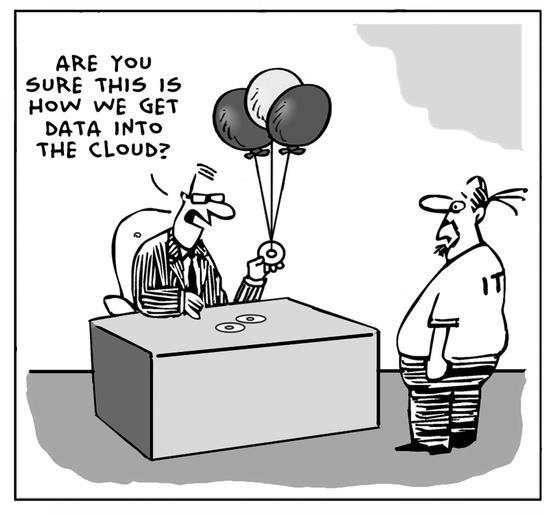Lost data among the "clouds"?
Cloud computing is the new Holy Grail of the hosting world. But what is it really? Perhaps this is the same as sitting with a computer on top of a mountain above the clouds, or flying in an airplane with a laptop?

The name "clouds" is actually not entirely correct. Data is hosted on servers in data centers and transmitted over completely tangible cable connections. Even wireless transmission requires special equipment. However, these same data centers are subject to the same interruptions in electricity, natural disasters and security threats. And, probably, security threats are even more serious, because A huge number of users work with clouds.
Cloud service providers use this method of data protection so that it is convenient for both users and the provider. As long as they maintain smooth operation and never lose data (although this is not the case), it is believed that providers perform user support quite well. But when large companies trust their data to cloud services, “good enough” is not enough to become. A large business works with a rather large amount of data that must be recoverable. To confirm an acceptable level of service, the parties must sign the Service Level Agreement.

This applies both to cloud providers owning their own data centers, and to those who rent sites in other people's data centers. And whoever provides you a cloud backup service, he must be responsible for ensuring that this data is recoverable. You may be promised the best uptime in the world, but if the data center is physically affected by floods, earthquakes, and tornadoes? Without an SLA, it is likely that you will lose your data forever.
How to protect yourself? Agree on the terms of service that will satisfy you.

Even the most reliable providers have unforeseen situations when they stop serving their users. Robust architecture and data structure provide superior accessibility and security of user information around the world. Do not let yourself be fooled, always carefully study the information on the provider's website. And if you are not sure about something - do not rush to the choice and always make backups. You can also use the services of several hosting providers that are located in different data centers, and only a plus when these data centers are located in different countries, and even better - on different continents.

The name "clouds" is actually not entirely correct. Data is hosted on servers in data centers and transmitted over completely tangible cable connections. Even wireless transmission requires special equipment. However, these same data centers are subject to the same interruptions in electricity, natural disasters and security threats. And, probably, security threats are even more serious, because A huge number of users work with clouds.
Cloud service providers use this method of data protection so that it is convenient for both users and the provider. As long as they maintain smooth operation and never lose data (although this is not the case), it is believed that providers perform user support quite well. But when large companies trust their data to cloud services, “good enough” is not enough to become. A large business works with a rather large amount of data that must be recoverable. To confirm an acceptable level of service, the parties must sign the Service Level Agreement.

This applies both to cloud providers owning their own data centers, and to those who rent sites in other people's data centers. And whoever provides you a cloud backup service, he must be responsible for ensuring that this data is recoverable. You may be promised the best uptime in the world, but if the data center is physically affected by floods, earthquakes, and tornadoes? Without an SLA, it is likely that you will lose your data forever.
What to look for in the Service Level Agreement
How to protect yourself? Agree on the terms of service that will satisfy you.
- Data protection and recovery. Choose providers that store data in geographically remote data centers that are well protected from natural disasters and power outages. Densely populated areas are not very suitable for data centers, as power grids there fail more often than in less populated ones.
- Data integrity and recovery. The provider must provide this. Not only nature can harm your data - disruptions within the infrastructure itself are also a threat. Add a point that the provider regularly confirms the integrity of the data. You also need to know what to expect in case of data loss and subsequent recovery. The SLA must consider the priority of recovery according to the importance of the information being restored.
- Get your Printed Service Level Agreement. Do not settle for any verbal assertions of continuous uptime. Because the provider makes profit from you, you must get good conditions of service. And if you pay more, you must be sure that you will receive a service commensurate with your investments.

Even the most reliable providers have unforeseen situations when they stop serving their users. Robust architecture and data structure provide superior accessibility and security of user information around the world. Do not let yourself be fooled, always carefully study the information on the provider's website. And if you are not sure about something - do not rush to the choice and always make backups. You can also use the services of several hosting providers that are located in different data centers, and only a plus when these data centers are located in different countries, and even better - on different continents.
